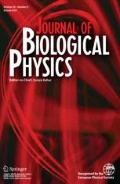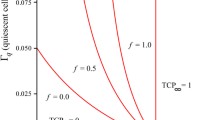Abstract
The treatment outcome of a given fractionated radiotherapy scheme is affected by oxygen tension and cell cycle kinetics of the tumor population. Numerous experimental studies have supported the variability of radiosensitivity with cell cycle phase. Oxygen modulates the radiosensitivity through hypoxia-inducible factor (HIF) stabilization and oxygen fixation hypothesis (OFH) mechanism. In this study, an existing mathematical model describing cell cycle kinetics was modified to include the oxygen-dependent G1/S transition rate and radiation inactivation rate. The radiation inactivation rate used was derived from the linear-quadratic (LQ) model with dependence on oxygen enhancement ratio (OER), while the oxygen-dependent correction for the G1/S phase transition was obtained from numerically solving the ODE system of cyclin D-HIF dynamics at different oxygen tensions. The corresponding cell cycle phase fractions of aerated MCF-7 tumor population, and the resulting growth curve obtained from numerically solving the developed mathematical model were found to be comparable to experimental data. Two breast radiotherapy fractionation schemes were investigated using the mathematical model. Results show that hypoxia causes the tumor to be more predominated by the tumor subpopulation in the G1 phase and decrease the fractional contribution of the more radioresistant tumor cells in the S phase. However, the advantage provided by hypoxia in terms of cell cycle phase distribution is largely offset by the radioresistance developed through OFH. The delayed proliferation caused by severe hypoxia slightly improves the radiotherapy efficacy compared to that with mild hypoxia for a high overall treatment duration as demonstrated in the 40-Gy fractionation scheme.







Similar content being viewed by others
Data availability
Data available on request from the author.
References
Dance, D.R., Christofides, S., Maidment, A.D.A., McLean, I.D., Ng, K.H.: Diagnostic radiology physics: A handbook for teachers and student. International Atomic Energy Agency, Vienna (2014)
Brady, L.W., Heilmann, H.P., Molls, M., Nieder, C.: Radiation oncology: An evidence-based approach. Springer, Berlin (2008)
Burney, I.A., Al-Moundhri, M.S.: Major advances in the treatment of cancer. Sultan Qaboos Univ. Med. J. 8(2), 137–148 (2008). https://www.ncbi.nlm.nih.gov/pmc/articles/PMC3074830/
Malone, E.R., Oliva, M., Sabatini, P.J.B., Stockley TL, Siu LL: Molecular profiling for precision cancer therapies. Genome Med. 12(1), 8 (2020). https://doi.org/10.1186/s13073-019-0703-1
Hall, E.J., Giaccia, A.J.: Radiobiology for the Radiologist. Wolters Kluwer, Philadelphia (2012)
Pawlik, T.M., Keyomarsi, K.: Role of cell cycle in mediating sensitivity to radiotherapy. Int. J. Radiat. Oncol. Biol. Phys. 59(4), 928–942 (2004). https://doi.org/10.1016/j.ijrobp.2004.03.005
Quintiliani, M.: Modification of radiation sensitivity: the oxygen effect. Int. J. Radiat. Oncol. Biol. Phys. 5(7), 1069–76 (1979). https://doi.org/10.1016/0360-3016(79)90621-7
Limas, J.C., Cook, J.G.: Preparation for DNA replication: the key to a successful S phase. FEBS Letters 593(20), 2853–67 (2019). https://doi.org/10.1002/1873-3468.13619
Foster, D.A., Yellen, P., Xu, L., Saqcena, M.: Regulation of G1 cell cycle progression: distinguishing the restriction point from a nutrient-sensing cell growth checkpoint(s). Genes Cancer 1(11), 1124–31 (2010). https://doi.org/10.1177/1947601910392989
Terasima, T., Tolmach, L.J.: Variations in several responses of HeLa cells to x-irradiation during the division cycle. Biophys. J. 3(1), 11–33 (1963). https://doi.org/10.1016/s0006-3495(63)86801-0
Valenzuela, M.T., Mateos, S., Ruiz de Almodóvar, J.M., McMillan, T.J.: Variation in sensitizing effect of caffeine in human tumour cell lines after gamma-irradiation. Radiotherapy Oncol. 54(3), 261–271 (2000). https://doi.org/10.1016/s0167-8140(99)00180-2
Sinclair, W.K.: Cyclic x-ray responses in mammalian cells in vitro. Radiat. Res. 33(3), 620–43 (1968)
Zhao, X., Wei, C., Li, J., Xing, P., Li, J., Zheng, S., Chen, X.: Cell cycle-dependent control of homologous recombination. Acta Biochimica et Biophysica Sinica 49(8):655–668 (2017). https://doi.org/10.1093/abbs/gmx055
Rankin, E.B., Giaccia, A.J.: Hypoxic control of metastasis. Science 352(6282), 175–180 (2016). https://doi.org/10.1126/science.aaf4405
Ziello, J.E., Jovin, I.S., Huang, Y.: Hypoxia-Inducible Factor (HIF)-1 regulatory pathway and its potential for therapeutic intervention in malignancy and ischemia. Yale J. Biol. Med. 80(2), 51–60 (2007)
Ramakrishnan, S., Anand, V., Roy, S.: Vascular endothelial growth factor signaling in hypoxia and inflammation. J. Neuroimmune Pharm. 9(2), 142–160 (2014). https://doi.org/10.1007/s11481-014-9531-7
Dang, C.V., Kim, J.W., Gao, P., Yustein, J.: The interplay between MYC and HIF in cancer. Nat. Rev. Cancer 8(1), 51–56 (2008). https://doi.org/10.1038/nrc2274
Khan, F., Ricks-Santi, L.J., Zafar, R., Kanaan, Y., Naab, T.: Expression of p27 and c-Myc by immunohistochemistry in breast ductal cancers in African American women. Ann. Diagn. Pathol. 34, 170–174 (2018). https://doi.org/10.1016/j.anndiagpath.2018.03.013
Bedessem, B., Stephanou, A.: A mathematical model of HiF-1\(\alpha\)-mediated response to hypoxia on the G1/S transition. Math. Biosci. 248, 31–39 (2014). https://doi.org/10.1016/j.mbs.2013.11.007
Zhang, B., Ye, H., Yang, A.: Mathematical modelling of interacting mechanisms for hypoxia mediated cell cycle commitment for mesenchymal stromal cells. BMC Syst. Biol. 12(1), 35 (2018). https://doi.org/10.1186/s12918-018-0560-3
Piantadosi, S., Hazelrig, J.B., Turner, M.E., Jr.: A model of tumor growth based on cell cycle kinetics. Math. Biosci. 66, 283–306 (1983). https://doi.org/10.1016/0025-5564(83)90094-9
Bentzen, S.M., Tucker, S.L.: Quantifying the position and steepness of radiation dose-response curves. Int. J. Radiat. Biol. 71(5), 531–542 (1997). https://doi.org/10.1080/095530097143860
McMahon, S.J.: The linear quadratic model: usage, interpretation and challenges. Phys. Med. Biol. 64, 01TR01 (2018). https://doi.org/10.1088/1361-6560/aaf26a
Kissick, M., Campos, D., Van der Kogel, A., Kimple, R.: On the importance of prompt oxygen changes for hypofractionated radiation treatments. Phys. Med. Biol. 58(20), N279–N285 (2013). https://doi.org/10.1088/0031-9155/58/20/N279
Grimes, D.R., Partridge, M.: A mechanistic investigation of the oxygen fixation hypothesis and oxygen enhancement ratio. Biomed. Phys. Eng. Express 1(4), (2015). https://doi.org/10.1088/2057-1976/1/4/045209
Milani, M., Harris, A.L.: Targeting tumour hypoxia in breast cancer. Eur. J. Cancer 44(18), 2766–73 (2008). https://doi.org/10.1016/j.ejca.2008.09.025
Bertuzzi, A., Gandolfi, A., Giovenco, M.A.: Mathematical models of the cell cycle with a view to tumor studies. Math. Biosci. 53(3–4), 159–188 (1981). https://doi.org/10.1016/0025-5564(81)90017-1
Basse, B., Baguley, B.C., Marshall, E.S., Wake, G.C., Wall, D.J.: Modelling cell population growth with applications to cancer therapy in human tumour cell lines. Prog. Biophys. Mol. Bio. 85(2–3), 353–368 (2004). https://doi.org/10.1016/j.pbiomolbio.2004.01.017
Sible, J.C., Tyson, J.J.: Mathematical modeling as a tool for investigating cell cycle control networks. Methods. 41(2), 238–247 (2007). https://doi.org/10.1016/j.ymeth.2006.08.003
Osborne, C.K., Boldt, D.H., Clark, G.M., Trent, J.M.: Effects of tamoxifen on human breast cancer cell cycle kinetics: accumulation of cells in early G1 phase. Cancer Res. 43(8), 3583–85 (1983)
Tubiana, M.: Tumor cell proliferation kinetics and tumor growth rate. Acta Oncol. (Stockholm, Sweden) 28(1), 113–121 (1989). https://doi.org/10.3109/02841868909111193
Cos, S., Recio, J., Sanchez-Barcelo, E.J.: Modulation of the length of the cell cycle time of MCF-7 human breast cancer cells by melatonin. Life Sci. 58(9), 811–816 (1996). https://doi.org/10.1016/0024-3205(95)02359-3
Ding, L., Cao, J., Lin, W., Chen, H., Xiong, X., Ao, H., Yu, M., Lin, J., Cui, Q.: The roles of cyclin-dependent kinases in cell-cycle progression and therapeutic strategies in human breast cancer. Int. J. Mol. Sci. 21(6), (2020). https://doi.org/10.3390/ijms21061960
Giacinti, C., Giordano, A.: RB and cell cycle progression. Oncogene 25(38), 5220–27(2006). https://doi.org/10.1038/sj.onc.1209615
Tashiro, E., Tsuchiya, A., Imoto, M.: Functions of cyclin D1 as an oncogene and regulation of cyclin D1 expression. Cancer Sci. 98(5), 629–635 (2007). https://doi.org/10.1111/j.1349-7006.2007.00449.x
Alarcon, T., Byrne, H.M., Maini, P.K.: A mathematical model of the effects of hypoxia on the cell-cycle of normal and cancer cells. J. Theor. Biol. 229(3), 395–411 (2004). https://doi.org/10.1016/j.jtbi.2004.04.016
Lacoste-Collin, L., Castiella, M., Franceries, X., Cassol, E., Vieillevigne, L., Pereda, V., Bardies, M., Courtade-Saïdi, M.: Nonlinearity in MCF7 cell survival following exposure to modulated 6 MV radiation fields: focus on the dose gradient zone. Dose-Response 13(4), (2015). https://doi.org/10.1177/1559325815610759
Lewin, T.D., Maini, P.K., Moros, E.G., Enderling, H., Byrne, H.M.: The evolution of tumour composition during fractionated radiotherapy: Implications for outcome. Bull. Math. Biol. 80(5), 1207–35 (2018). https://doi.org/10.1007/s11538-018-0391-9
Carlson, D.J., Stewart, R.D., Semenenko, V.A.: Effects of oxygen on intrinsic radiation sensitivity: A test of the relationship between aerobic and hypoxic linear-quadratic (LQ) model parameters. Med. Phys. 33(9), 3105–15 (2006). https://doi.org/10.1118/1.2229427
Wenzl, T., Wilkens, J.J.: Theoretical analysis of the dose dependence of the oxygen enhancement ratio and its relevance for clinical applications. Radiat. Oncol. 6, 171 (2011). https://doi.org/10.1186/1748-717X-6-171
Oroji, A., Omar, M., Yarahmadian, S.: An Îto stochastic differential equations model for the dynamics of the MCF-7 breast cancer cell line treated by radiotherapy. J. Theor. Biol. 407, 128–137 (2016). https://doi.org/10.1016/j.jtbi.2016.07.035
Koulis, T.A., Phan, T., Olivotto, I.A.: Hypofractionated whole breast radiotherapy: current perspectives. Breast Cancer (Dove Medical Press) 7, 363–373 (2015). https://doi.org/10.2147/BCTT.S81710
Khan, F.M., Gibbons, J.P.: Khan’s The Physics of Radiation Therapy. Wolters Kluwer, Philadelphia (2014)
Gardner, L.B., Li, Q., Park, M.S., Flanagan, W.M., Semenza, G.L., Dang, C.V.: Hypoxia inhibits G1/S transition through regulation of p27 expression. J. Biol. Chem. 276(11), 7919–7926 (2001). https://doi.org/10.1074/jbc.M010189200
Willers, H., Azzoli, C.G., Santivasi, W.L., Xia, F.: Basic mechanisms of therapeutic resistance to radiation and chemotherapy in lung cancer. Cancer J. 19(3), 200–207 (2013). https://doi.org/10.1097/PPO.0b013e318292e4e3
Marks, L.B., Dewhirst, M.: Accelerated repopulation: friend or foe? Exploiting changes in tumor growth characteristics to improve the “efficiency” of radiotherapy. Int. J. Radiat. Oncol. Biol. Phys. 21(5), 1377–83 (1991). https://doi.org/10.1016/0360-3016(91)90301-j
Sutherland, R.L., Hall, R.E., Taylor, I.W.: Cell proliferation kinetics of MCF-7 human mammary carcinoma cells in culture and effects of tamoxifen on exponentially growing and plateau-phase cells. Cancer Res. 43(9), 3998–4006 (1983)
Withers, H.R.: Cell cycle redistribution as a factor in multifraction irradiation. Radiology 114(1), 199–202 (1975). https://doi.org/10.1148/114.1.199
Jones, L., Hoban, P., Metcalfe, P.: The use of the linear quadratic model in radiotherapy: a review. Australas. Phys. Eng. Sci. Med. 24(3), 132–146 (2001). https://doi.org/10.1007/BF03178355
Funding
The author has not received specific funding for this work.
Author information
Authors and Affiliations
Corresponding author
Ethics declarations
Ethical approval
This article does not contain any studies with human or animal subjects performed by the author.
Conflict of interest
The author declares that they have no conflict of interest.
Additional information
Publisher’s Note
Springer Nature remains neutral with regard to jurisdictional claims in published maps and institutional affiliations.
Rights and permissions
About this article
Cite this article
Remigio, A.S. In silico simulation of the effect of hypoxia on MCF-7 cell cycle kinetics under fractionated radiotherapy. J Biol Phys 47, 301–321 (2021). https://doi.org/10.1007/s10867-021-09580-x
Received:
Accepted:
Published:
Issue Date:
DOI: https://doi.org/10.1007/s10867-021-09580-x




